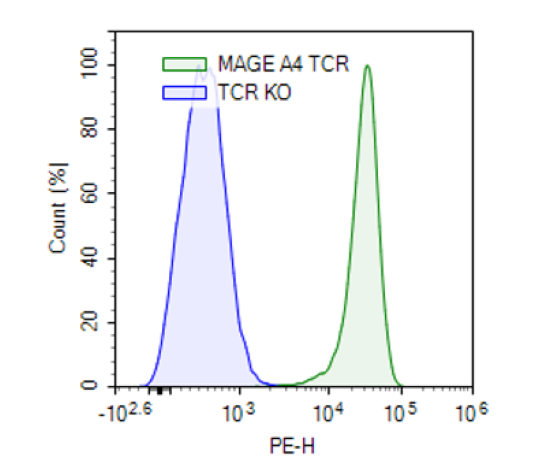MAGE-A4 TCR CD8+ NFAT-Luciferase Reporter Jurkat Cell Line
MAGE-A4 CD8+ NFAT-Luciferase Reporter Jurkat Cell Line was generated from T Cell Receptor (TCR) Knockout NFAT Luciferase Reporter Jurkat Cell Line (BPS Bioscience #78556) by overexpression of human CD8 (NM_001768.6) and a MAGE-A4 (Melanoma-associated antigen 4)-directed TCR using lentiviral transduction (CD8a Lentivirus #78648 and MAGE-A4-Specific TCR Lentivirus #78935). This human MAGE-A4 TCR specifically recognizes an antigen corresponding to MAGE-A4 peptide, amino acids 230-239 (GVYDGREHTV).

Figure 1: Illustration of the functional co-culture assay used to validate the MAGE-A4 TCR CD8+ NFAT-Luciferase Reporter Jurkat Cell Line.
Purchase of this cell line is for research purposes only; commercial use requires a separate license. View the full terms and conditions.
| Name | Ordering Information |
| Thaw Medium 2 | BPS Bioscience #60184 |
| Growth Medium 2T | BPS Bioscience #78756 |
| Assay Medium 2D | BPS Bioscience #78755 |
| CD8+ TCR KO NFAT Luciferase Reporter Jurkat Cell Line | BPS Bioscience #78757 |
| T2 Cell Line | ATCC #CRL-1992 |
| MAGE-A4 (230-239) Peptide | BPS Bioscience #78966 |
| PE anti-human α/β T Cell Receptor Antibody | BioLegend #306707 |
| ONE-Step™ Luciferase Assay System | BPS Bioscience #60690 |
| 96-well tissue culture plate, white, clear bottom |
The cell line has been screened to confirm the absence of Mycoplasma species.
MAGE (melanoma associated antigen) proteins are CT (cancer testis) antigens, and there are about 60 proteins in the MAGE family that can be subdivided into type I (present only on the X-chromosome, MAGE-A, B, and C) and type II (MAGE D-L and necdin). Under normal conditions they are mostly found in the testis and placenta. They are found at high levels in several cancer types, such as melanoma, brain, and breast cancer, and are involved in the development of resistance to chemotherapy, cell motility, and cell survival. Expression of MAGE proteins tend to correlate with a poor prognosis. They are intracellular proteins, with MAGE-A4 being found in the cytosol and nucleus, making them poor targets for strategies such as CAR-T cell therapy. MAGE proteins are degraded in the proteosome, and the peptides created can then be found on the cell membrane in combination with MHC (major histocompatibility complex) I. Presentation on the cell surface makes them an attractive target for TCR (T cell receptor)-T cell therapy. Several clinical trials are ongoing, and either alone or in combination with other forms of cancer therapy the use of TCR-T cells targeting MAGE-A antigens may become a promising therapeutic avenue.
CD8 (Cluster of Differentiation 8) is a co-receptor of TCR and a typical marker of cytotoxic T cells. The TCR protein complex is found on the surface of T cells and is responsible for recognizing antigens bound to MHC (Major Histocompatibility Complex) molecules. Stimulation of the TCR results in activation of downstream NFAT (Nuclear factor of Activated T-cells) transcription factors that induce the expression of various cytokines such as interleukin-2 to 4, and TNF-alpha. The use of engineered TCR allows T cells to target specific antigens present in cancer cells via the MHC, expanding the portfolio of antigens that can be targeted in cancer cell therapy.



